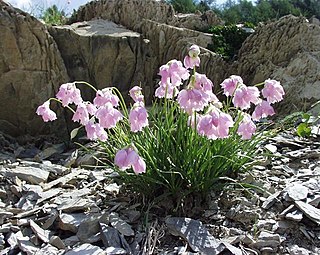
Herring are forage fish, mostly belonging to the family of Clupeidae.

The macaques constitute a genus (Macaca) of gregarious Old World monkeys of the subfamily Cercopithecinae. The 23 species of macaques inhabit ranges throughout Asia, North Africa, and Europe. Macaques are principally frugivorous, although their diet also includes seeds, leaves, flowers, and tree bark. Some species such as the long-tailed macaque will supplement their diets with small amounts of meat from shellfish, insects, and small mammals. On average, a southern pig-tailed macaque in Malaysia eats about 70 large rats each year. All macaque social groups are arranged around dominant matriarchs.

Trachypithecus is a genus of Old World monkeys containing species known as lutungs, langurs, or leaf monkeys. Their range is much of Southeast Asia.

Polemonium acutiflorum, known as tall Jacob's-ladder, is a flowering plant in the family Polemoniaceae. It is native to western Canada and Alaska.

Allium moly, also known as yellow garlic, golden garlic and lily leek, Is a species of flowering plant in the genus Allium, which also includes the flowering and culinary onions and garlic. A bulbous herbaceous perennial from the Mediterranean, it is edible and also used as a medicinal and ornamental plant.
This article is a list of biological species, subspecies, and evolutionary significant units that are known to have become extinct during the Holocene, the current geologic epoch, ordered by their known or approximate date of disappearance from oldest to most recent.

Aloe peglerae is a small, stemless South African aloe. This unique succulent plant is classed as an endangered species. The species was listed by CITES as an Appendix II species, requiring special trade protections to prevent the further endangerment of the current wild population due to the plant trade.

Mammillaria hahniana, the old lady cactus, is a species of flowering plant in the family Cactaceae, native to central Mexico. It grows to 25 cm (10 in) tall by 50 cm (20 in) broad. The solitary spherical stems, 12 cm in diameter, are covered in white down and white spines. Reddish purple flowers are borne in spring and summer, sometimes forming a complete ring around the apex of the plant.

Prunus brigantina, called Briançon apricot, Briançon plum, marmot plum, and Alpine apricot, is a wild tree species native to France and Italy. Its fruit is edible and similar to the commercial apricot P. armeniaca, but it is smooth unlike apricots. An edible oil produced from the seed, 'huile des marmottes', is used in France.

Allium macrostemon, Chinese garlic, Japanese garlic or long-stamen onion, is a species of wild onion widespread across much of East Asia. It is known from many parts of China, as well as Japan, Korea, Mongolia, Tibet and Primorye. It has been collected from elevations ranging from sea level to 3000 m.

Allium ericetorum is a species of Allium widespread across much of southern and central Europe, from Portugal to Ukraine.

Allium narcissiflorum is a European species of wild onion native to northwestern Italy, southwest France. It is grown in other regions as an ornamental because of its pretty flowers.

Haageocereus bylesianus is a critically endangered species of Haageocereus from Peru.













